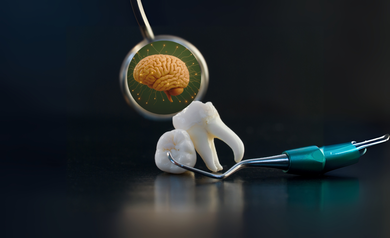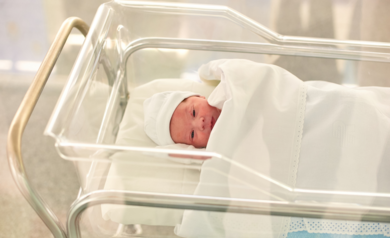- Health Conditions A-Z
- Health & Wellness
- Nutrition
- Fitness
- Health News
- Ayurveda
- Videos
- Medicine A-Z
- Parenting
- Web Stories
Diagnostic Anomaly: This Man’s Brain Began Bleeding After A Regular Dental Checkup

Credits: Canva
'Diagnostic Anomaly' is a Health And Me Series, where we dive deep into some of the rarest of rare diseases. Here, we trace such diseases and what causes them. We also try to bring case studies around the same.
A routine dentist appointment turned into a medical emergency for a man in his late 60s living in Australia. Just 30 minutes after having two teeth extracted, he began experiencing sudden and alarming symptoms — dizziness, vomiting, and a bizarre distortion in his vision, where the world appeared rotated 90 degrees counterclockwise.
These were not trivial side effects of anesthesia or stress. The symptoms were pointing to something much worse. When he came to the emergency room, physicians observed strange signs: abnormal eye movement to the left and a tendency to fall to the right when walking. A brain scan validated their suspicion he was having an intracerebral hemorrhage (ICH), a potentially fatal form of stroke due to bleeding in the brain.
Intracerebral hemorrhage constitutes 10–15% of all strokes and entails a ruptured vessel bleeding into the brain tissue. Ischemic strokes caused by obstructions do not need such immediate intervention, while ICH needs to be urgently treated to stop bleeding, reduce brain pressure, and avoid irreversible neurological injury.
In this patient, the bleeding was in the lower-left side of his brain — a region that affects balance, coordination, and vision. His health care team reacted quickly to treat the hemorrhage, decrease his blood pressure, and relieve intracranial pressure. Thankfully, after receiving immediate treatment, he was stabilized and released with medication to regulate his blood pressure.
Three months after that, he made a dramatic recovery. His eyesight was back to normal, and his balance also considerably improved. To prevent future strokes over the long term, he was put on aspirin, which prevents narrowing of the blood vessels in the brain by keeping the blood thin.
Although clinically managing the case was according to typical stroke procedure, what makes this case uncommon is the suspected etiology: a simple dental treatment.
The man’s symptoms began just half an hour after his tooth extraction. Medical literature contains a few rare reports of individuals experiencing ICH following dental procedures, possibly due to sharp spikes in blood pressure triggered by pain, anxiety, or physiological stress. In this case, the working theory is that the dental procedure, coupled with an undiagnosed underlying condition, created the perfect storm for a stroke.
What Is White Matter Disease?
As the medical staff delved deeper into his background, they discovered further hints. Only six weeks earlier, the man had received neurological tests for potential Parkinson's disease. Scans at the time had already indicated signs of white matter disease — abnormalities in the network of wiring in the brain, which can cause thought to be slower, lead to loss of balance, and predispose to stroke and dementia.
White matter disease targets the brain's "communication highways," the nerve fibers (axons) that carry signals between different areas of the brain and spinal cord. The fibers need a continuous supply of oxygen and nutrients. When blood flow is slowed — because of age, high blood pressure, or damaged vessels — the white matter breaks down, creating lesions that are seen on MRI scans.
Symptoms of white matter disease may range from memory loss, difficulty with coordination, sluggish movement, mood changes, and even urinary incontinence. The symptoms are worse if the damage is more extensive.
But the story didn't end there. Genetic studies of the man revealed he had an uncommon mutation associated with CADASIL-Cerebral Autosomal Dominant Arteriopathy with Subcortical Infarcts and Leukoencephalopathy. This inherited disorder is found in approximately 2 in 100,000 and causes blood vessel walls to thicken. This compromise results in reduced flow of blood into the brain and a drastically increased risk of stroke.
Other research implies ICH can be an complication of CADASIL, particularly when added on top of other influences such as high blood pressure or physical stress.
The course of events now makes sense. The patient's existing white matter disease already compromising brain connectivity and his unknown CADASIL mutation had left his brain's blood vessels particularly susceptible.
The dental removal, though apparently innocuous, perhaps triggered an increase in blood pressure due to stress or pain, a normal physiological reaction in a medical context. For a person with healthy blood vessels, this may not have resulted in anything. But with a brain containing constricted, weakened vessels, the pressure was sufficient to rupture a vessel resulting in an intracerebral hemorrhage.
How Small Triggers Meet Big Risks
This case is an admonition regarding the intricate intersection of genetics, chronic illness, and acute medical stressors. It also highlights the need for recognition and control of risk factors such as hypertension, white matter disease, and unrecognized genetic disorders that affect brain function.
For individuals with cardiovascular risk factors — for example, diabetes, hypertension, or high cholesterol — regular procedures, including dental treatment, might necessitate closer follow-up. Preventive interventions, such as brain imaging in individuals with neurological symptoms and a history of stroke or dementia in first-degree relatives, might detect conditions such as CADASIL before complications arise.
Can White Matter Disease Be Prevented?
Although some white matter changes are inevitable with aging, progression can be slowed down. Good management of heart and vascular health is key. Here's what doctors say:
- Keep blood pressure under control
- Manage high cholesterol and diabetes
- Stop smoking
- Be physically active
- Eat a heart-healthy diet (such as the Mediterranean diet)
Studies have established that lowering cardiovascular risk has been proven to reduce white matter lesions, thus reducing stroke, dementia, and physical disability risks later in life.
A routine dentist visit triggered a series of events that almost resulted in a catastrophe for this Australian man but with timely rescue and extensive diagnostic procedures, not only did he recover well, but the doctors also discovered a rare genetic disorder that might have been a future threat.
Occasionally, the body's reaction to less invasive procedures can expose deep-rooted problems. Paying attention to your body, reporting new symptoms, and being proactive about brain and heart health can be the difference-maker — particularly when the indicators are easy to miss.
US Fertility Rate Crawled To A Record Low In 2024, CDC Confirms; Should We Be Alarmed?

Credits: Canva
The U.S. fertility rate dropped to its lowest recorded point in 2024, with fewer than 1.6 children per woman, according to newly released data from the Centers for Disease Control and Prevention (CDC). The statistic marks a continuation of a nearly two-decade-long trend in declining birth rates, one that has shifted the United States closer to the demographic profile of Western European countries.
For context, a fertility rate of 2.1 children per woman is considered the “replacement level,” the point at which a generation can, theoretically, replace itself. The U.S. hovered near that threshold until the late 2000s. But since then, it has slipped steadily, and 2024’s rate of 1.599 puts it well below what’s needed for generational stability without immigration.
Behind the numbers are real-world pressures shaping family planning decisions. Today’s young adults are marrying later, starting families later—or opting out entirely. Financial uncertainty plays a significant role.
“People are concerned about whether they can afford to have children—not just the cost of childbirth, but long-term needs like childcare, housing, and health insurance,” said Karen Guzzo, director of the Carolina Population Center at the University of North Carolina. “Worry is not a good moment to have kids.”
The cost of raising a child in the U.S. has climbed steadily, outpacing wage growth in many parts of the country. And while millennials and Gen Z have higher educational attainment than previous generations, they also carry more debt, face steeper housing markets, and often work in jobs with fewer benefits.
The Long Arc of Decline
To understand the drop in fertility, it's important to zoom out. In the early 1960s, during the postwar baby boom, the U.S. total fertility rate peaked around 3.5. But by the mid-1970s, it had plummeted to 1.7, largely due to the availability of birth control, changing gender roles, and cultural shifts around family size.
There was a brief rebound in the early 2000s, with the rate rising to 2.1 in 2007. But the 2008 financial crisis triggered another sharp downturn—and the recovery in births never quite came.
According to the CDC’s National Center for Health Statistics, the fertility rate in 2023 was 1.621, before dipping further to 1.599 in 2024.
Why Is Trump Administration’s Pushing to Reverse the Trend?
Concerned about declining birth rates, the Trump administration has recently taken steps to try to stimulate family formation. These include:
- An executive order aimed at expanding and reducing the cost of in vitro fertilization (IVF)
- Public endorsements of “baby bonus” incentives, which would provide financial rewards to couples who have children
However, experts remain skeptical of these measures. "These are largely symbolic moves,” said Guzzo. “They don’t address the real obstacles facing families, like paid parental leave, affordable childcare, and housing affordability. Until those are on the table, you’re not going to see a meaningful change.”
While the overall fertility rate declined, total births actually rose in 2024. According to the CDC’s finalized data, there were about 33,000 more births than the previous year, bringing the annual total to just over 3.6 million babies.
This may seem contradictory at first glance. But demographers say it makes sense once you factor in changes in population estimates.
The U.S. Census Bureau updated its estimates for the number of women of childbearing age. The increase in this demographic—largely driven by immigration offset small increases in births in certain age groups, leading to a recalculated (and lower) birth rate.
Initial projections earlier in 2024 suggested that women in their late 20s and 30s were having more children. But the updated report, based on a more complete dataset, found:
- Declines in birth rates for women in their 20s and early 30s
- No significant change for women in their late 30s
So while there may have been slightly more babies born, the pool of women able to give birth also grew—especially due to immigrant populations—pulling the overall fertility rate downward.
Should We Be Alarmed?
Not necessarily. Unlike countries like Japan or Italy, where shrinking populations are already straining healthcare systems and economies, the U.S. population is still growing, thanks largely to immigration. And while birth rates are falling, experts emphasize that this is often a delay, not an outright decision never to have children.
“What we’re seeing is people having kids later, not necessarily choosing not to have them at all,” said Root. “The U.S. still has a natural increase—more births than deaths.”
That said, the economic and policy environments matter. In countries like Sweden and France, which offer strong parental leave policies and subsidized childcare, birth rates have remained more stable despite similar social trends.
As debates about immigration and population policy heat up, the fertility rate is increasingly seen as more than just a demographic metric—it’s a political one.
A sustained drop below replacement level, without compensatory immigration, could eventually lead to workforce shortages, strains on entitlement programs, and broader economic shifts. But solutions, experts argue, will require more than one-time bonuses or headline-grabbing executive orders.
If the U.S. wants to encourage family formation, it will need to invest meaningfully in family support systems: paid leave, healthcare, housing, education, and affordable childcare. Otherwise, the gap between ideal family size and actual fertility will continue to widen.
The drop to a 1.599 fertility rate in 2024 is a milestone but not an emergency. It's a reflection of changing cultural, economic, and personal dynamics in American life. Addressing it will require real policy innovation, not just political talking points.
For now, Americans are still having children, just on their own timeline, and often with more questions than confidence.
Skipping This Basic Yet Vital Oral Hygiene Step Could Put You In Trouble

Most of us brush twice a day, some of us floss, and the enthusiastic few even use a mouthwash that burns like fire. But there’s one thing we’re all guilty of skipping, and that is tongue scraping. Skipping this tiny but mighty step could be the reason your oral hygiene isn’t quite hitting the mark. And it's not just about bad breath.
What is the white film on your tongue in the morning?
That whitish layer on your tongue when you wake up is not just sleep residue or leftover toothpaste. It's a delightful mix of bacteria, dead cells, food debris and other gunk. Tongue scraping removes this film before it gets a chance to cause trouble.
This Is What Happens If You Don’t Scrape
1. Bad Breath
No matter how minty your toothpaste or fancy your mouthwash, if your tongue is coated in bacteria, you’re going to have bad breath. Halitosis is often caused by anaerobic bacteria that sit on the tongue and release foul-smelling sulphur compounds. A few scrapes each morning can keep that stink in check.
2. Taste Suffers
Ever feel like food doesn’t taste quite as good as it used to? It might be because your taste buds are trapped under layers of gunk. Scraping the tongue helps clear the surface, making your sense of taste sharper and more responsive.
3. Overall Health Affected
The mouth is connected to the rest of your body, and poor oral hygiene has been linked to a range of health issues, from heart disease to diabetes. The bacteria on your tongue can enter your bloodstream through micro-abrasions in your mouth, causing inflammation in other parts of your body.
It’s an Ancient Practice
While influencers are only now discovering the joys of tongue scraping, this practice has been around for centuries, particularly in Ayurveda, where it’s considered an essential part of morning cleansing rituals. Traditional medicine has long acknowledged the tongue as a mirror to internal health, and scraping is believed to help remove toxins and stimulate digestive enzymes.
The Right Way to Do It
- Use a proper tongue scraper. Not your toothbrush. Toothbrushes don’t clean the tongue effectively and can actually push debris further in.
- Scrape gently from back to front. You’ll probably gag the first few times, but start slow and go as far back as you can comfortably manage.
- Rinse and repeat. Twice if needed. Then rinse your mouth. Done in under 30 seconds.
Adding this simple step to your routine could mean fewer dental visits, fresher breath, and even better digestion.
6 Surprisingly Cool Benefits of Taking a Cold Plunge

We know. We know. Willingly dipping yourself into freezing water is not everyone's idea of a good time. In fact, it’s the stuff most nightmares are made of. But people are queuing up to do it. Whether it’s a tub full of ice cubes or a freezing lake at 6am, cold plunges are a thing. While you will be surprised to know the benefits, first know what exactly happens when you put your body through this temporary torture.
From giving your mood a caffeine-free lift to helping muscles relax, here's what makes cold plunging the icy wellness trend for your body and brain.
1. Boosts Your Mood
A few minutes in icy water can deliver a euphoric high. That’s because cold exposure triggers a rush of endorphins, your body’s natural feel-good chemicals. It also reduces cortisol, the stress hormone. Some studies even suggest that cold water immersion can help ease symptoms of depression and anxiety.
2. Recovers Muscles
Ever wonder why athletes dunk themselves in icy baths post-game? Cold plunges help reduce inflammation, speed up muscle recovery, and soothe soreness. When you expose your body to extreme cold, blood vessels constrict. Once you’re out and warming up, they dilate, increasing blood flow to tired muscles.
3. Improves Sleep
Taking a cold plunge can actually help you sleep better. Post-immersion, your body enters a state of deep relaxation once it warms back up. Your nervous system settles down, and your sleep hormones kick in more efficiently.
4. Boosts Immune System
Regular cold plunges may also give your immune system a little kick in the pants. The cold stimulates white blood cell production, which helps your body fight off illness. Some studies have found that people who practise cold water immersion regularly tend to get fewer colds and recover faster.
5. Makes Your Skin Glow
Cold water tightens your pores, reduces puffiness, and boosts circulation to your skin. It’s basically nature’s version of a toner. Plus, by reducing inflammation and flushing out toxins, your skin is left looking brighter, fresher, and decidedly more awake than you feel.
6. Teaches You to Breathe
Ever tried to breathe normally when your body is screaming from shock? Cold plunges force you to master your breath. That slow, deep breathing you’re encouraged to do during the first freezing minute? It’s not just to stop you from panicking. It actually helps train your nervous system to stay calm under pressure, build mental resilience, and reduce anxiety over time.
In a nutshell, cold plunging isn’t just a weird wellness trend. It’s a full-body and mind experience that comes with some genuinely impressive health benefits. Yes, it’s uncomfortable. Yes, you’ll want to scream. But after a while, you might just find yourself looking forward to it.
© 2024 Bennett, Coleman & Company Limited

